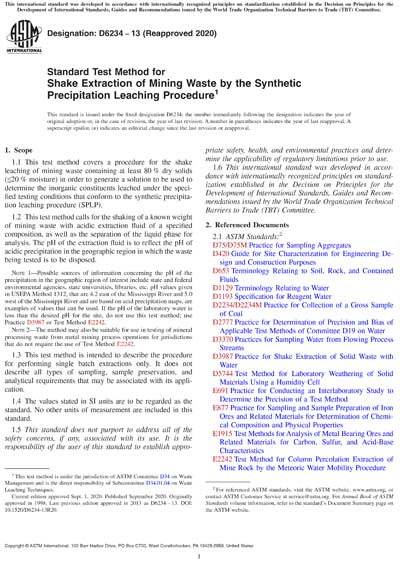Most recent
ASTM D6234-13(2020)
Standard Test Method for Shake Extraction of Mining Waste by the Synthetic Precipitation Leaching Procedure
1.1 This test method covers a procedure for the shake leaching of mining waste containing at least 80 % dry solids (≤20 % moisture) in order to generate a solution to be used to determine the inorganic constituents leached under the specified testing conditions that conform to the synthetic precipitation leaching procedure (SPLP).
1.2 This test method calls for the shaking of a known weight of mining waste with acidic extraction fluid of a specified composition, as well as the separation of the liquid phase for analysis. The pH of the extraction fluid is to reflect the pH of acidic precipitation in the geographic region in which the waste being tested is to be disposed.
Note 1: Possible sources of information concerning the pH of the precipitation in the geographic region of interest include state and federal environmental agencies, state universities, libraries, etc. pH values given in USEPA Method 1312, that are 4.2 east of the Mississippi River and 5.0 west of the Mississippi River and are based on acid precipitation maps, are examples of values that can be used. If the pH of the laboratory water is less than the desired pH for the site, do not use this test method; use Practice D3987 or Test Method E2242.
Note 2: The method may also be suitable for use in testing of mineral processing waste from metal mining process operations for jurisdictions that do not require the use of Test Method E2242.
1.3 This test method is intended to describe the procedure for performing single batch extractions only. It does not describe all types of sampling, sample preservation, and analytical requirements that may be associated with its application.
1.4 The values stated in SI units are to be regarded as the standard. No other units of measurement are included in this standard.
1.5 This standard does not purport to address all of the safety concerns, if any, associated with its use. It is the responsibility of the user of this standard to establish appropriate safety, health, and environmental practices and determine the applicability of regulatory limitations prior to use.
1.6 This international standard was developed in accordance with internationally recognized principles on standardization established in the Decision on Principles for the Development of International Standards, Guides and Recommendations issued by the World Trade Organization Technical Barriers to Trade (TBT) Committee.
Content Provider
ASTM International [astm]






